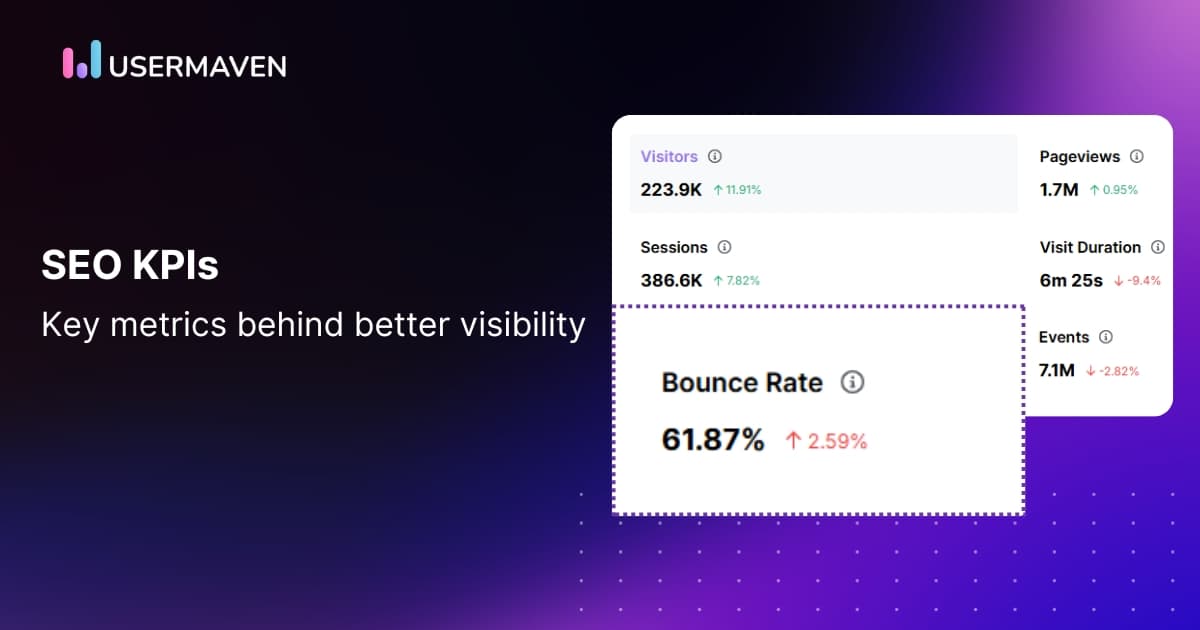Chasing vanity metrics? Here’s how to shift your focus to real impact
Aug 18, 2025
8 mins read
Written by Esha Shabbir

You’ve just wrapped up a new marketing campaign, and the numbers are rolling in. Your social media engagement? Through the roof. Website traffic? Skyrocketing. It feels like a victory, right?
But as the dust settles, you start to wonder: What’s actually changed? Are these numbers really helping your business grow, or are they just… numbers?
If you’ve ever felt this way, you’re not alone. It’s easy to get caught up in the excitement of these “big numbers.” But if you’re not careful, you might be celebrating success that doesn’t actually matter.
Let’s take a moment to explore why focusing on the right numbers in your analytics tool can make all the difference, and how you can avoid the trap of chasing vanity metrics.
What are vanity metrics?
Vanity metrics are numbers that look impressive at first glance but don’t help you make informed business decisions or achieve your goals. These numbers are flashy, but they don’t always paint the whole picture. They don’t tell you whether your audience is genuinely interested in what you’re offering or if your marketing efforts are translating into growth.
Take this example: you get 10x more website visitors this month. Sounds amazing, right? But if none of them convert into paying users, was that spike in traffic actually helping your business grow?
So, why do we get so hooked on these metrics?
The answer is simple: they’re easy to measure. They’re easy to track. It’s tempting to get excited about these numbers because they provide a quick, feel-good snapshot of your efforts.
But just because they’re simple doesn’t mean they’re valuable. In fact, focusing too much on vanity metrics can distract you from what truly matters.
When you leverage analytics effectively, you can move beyond these surface-level numbers and focus on the data that truly drives your business forward. The right metrics will provide a clearer picture of what’s truly driving growth and help guide your decisions toward smarter, more effective strategies that align with your goals.
Why are vanity metrics bad for your business?
Vanity metrics can create a false sense of success. It’s easy to get excited when you see big numbers: more traffic, more followers, more likes. However, these metrics don’t always tell you what’s actually driving growth. They might look impressive, but they don’t necessarily align with your real business goals.
Focusing too much on these flashy figures can lead you to misallocate resources. You may end up investing time, money, and effort in areas that aren’t yielding the desired results. Chasing vanity metrics could mean wasting marketing budgets on initiatives that don’t contribute to your bottom line.
And here’s where it gets tricky: relying on vanity metrics can harm your long-term strategy. If you’re making decisions based on these misleading numbers, you could be steering your business in the wrong direction. Instead of focusing on actionable insights that lead to informed choices, you risk getting stuck on data that doesn’t truly matter.
Without the right metrics, you could miss the opportunity to make data-driven decisions that foster long-term growth and help you adapt to what really drives success.
Vanity metrics vs. actionable metrics
When it comes to tracking success, not all metrics are created equal. While vanity metrics may look good on paper, actionable metrics are the ones that drive meaningful business change. But what exactly sets these two apart?
Actionable metrics are data points that are tied directly to your business outcomes and strategic goals. These metrics enable you to make informed decisions that drive growth and improvement. Unlike vanity metrics, which can be misleading, actionable metrics give you insights that directly impact ROI, customer engagement, and long-term business strategy.
For example, metrics such as customer acquisition cost (CAC), churn rate, and monthly active users (MAU), as well as revenue analytics, are actionable; they are directly linked to what drives your business forward. These are the numbers that matter.
Let’s take a closer look at how vanity metrics and actionable metrics differ:
| Vanity metrics | Actionable metrics |
| Often surface-level and easy to track | Tied to tangible business outcomes and goals |
| Don’t provide deep insights for decision-making | Provide insights that drive strategy and growth |
| May look impressive but lack value | Directly linked to ROI, customer engagement, and performance |
| Can lead to misallocation of resources | Help optimize resource allocation and investments |
| Example: Total followers, impressions, website traffic | Example: Retention rate, conversion rate, customer lifetime value |
| Give a false sense of success | Help identify areas for improvement and adaptation |
Common examples of vanity metrics
When it comes to tracking success, vanity metrics are often the first numbers we see and celebrate. But let’s take a closer look at some common ones, and why they might not tell you the whole story.

Social media metrics
Likes, shares, and follower counts can give you a sense of progress. After all, these metrics show that people are engaging with your content, right?
But here’s the catch: while they might make your numbers look good, they don’t necessarily reflect deep engagement or interest in your product. A high number of likes or shares doesn’t mean people are moving down your sales funnel, and it certainly doesn’t guarantee conversions.
Website traffic metrics
Page views, sessions, and unique visitors are commonly celebrated metrics. It feels great to see an increase in visits, but these numbers alone don’t reveal much.
Without context, these metrics don’t tell you if visitors are actually engaging with your content or taking the actions you care about. More traffic can be great, but if it’s not translating into conversions or customer actions, you’re just attracting visitors without a clear ROI.
Email marketing metrics
Open rates and click-through rates (CTR) are often used to measure the success of email campaigns. Sure, they show you how many people opened your emails or clicked through to your content.
But these metrics can be misleading without conversion tracking. Just because someone clicked doesn’t mean they took the next step: whether it’s signing up, purchasing, or engaging further down your email marketing funnel. Without tracking what happens next, these numbers can leave you in the dark.
App download numbers
App downloads are another number that can seem like a win. The more people who download your app, the more successful your campaign will be, right?
Not quite. Download numbers don’t accurately reflect the number of people using the app, whether they’re active users, or if they’ve uninstalled it shortly after downloading. Engagement and retention matter far more than initial downloads.
Search engine ranking
Ranking high on Google can make it feel like your SEO efforts are working. But what if that top spot doesn’t lead to conversions?
High rankings don’t always mean high-quality organic traffic. If your visitors aren’t converting or if the traffic isn’t aligned with your target audience, that top ranking might not be as valuable as you think.
While it’s great to see your site listed at the top, the true value lies in the actions your visitors take once they arrive. If they’re not engaging or completing desired actions, your search engine ranking is just a number with little impact on your bottom line.
How to avoid tracking vanity metrics
Tracking the right metrics is key to driving meaningful business results. But, when you get caught up in vanity metrics, it’s easy to get distracted by numbers that look good but don’t actually tell you what’s working.
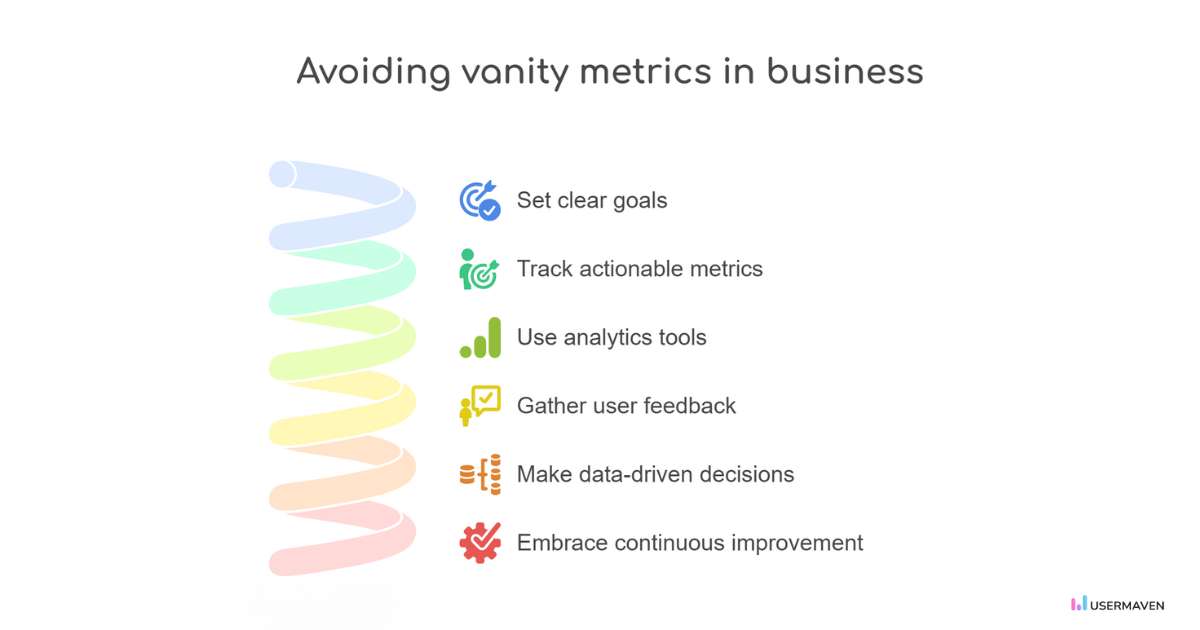
So how do you avoid falling into this trap and focus on metrics that truly matter? Let’s break it down.
Set clear and measurable goals
Tracking goals is the foundation of effective analytics, but before you start monitoring anything, you need to know why you’re doing so. What are you trying to achieve? Whether it’s driving conversions, improving customer retention, or boosting brand awareness, your goals need to be clear and specific.
When you define your goals, it becomes much easier to identify the right metrics. You’ll know exactly what data points to focus on, rather than getting caught up in numbers that don’t directly contribute to your success. And, don’t forget to communicate these goals with your team; they’ll be crucial in aligning your efforts and keeping everyone on track.
Track actionable metrics
Once your goals are defined, it’s time to choose the metrics that will help you gauge your progress. Actionable metrics provide real insights into your performance, enabling you to take meaningful steps forward. For example, instead of tracking a generic number of page views, focus on metrics like conversion rates or customer acquisition costs that directly impact your bottom line.
Remember, quality over quantity is key. You don’t need to track every metric under the sun. Instead, concentrate on the ones that truly move the needle and reflect how well your strategy is performing.
Use analytics tools to get the right insights
With the right tools, you can track and analyze the metrics that matter most. Platforms like Usermaven can provide you with insights into user behavior, conversions, and engagement: all critical pieces of the puzzle. These analytics tools help you cut through the noise and avoid getting distracted by vanity metrics.
A study by Gartner shows that marketing analytics influence just over half (53%) of marketing decisions, highlighting the importance of focusing on actionable data rather than superficial numbers.
By leveraging the data available through these tools, you can uncover patterns, see what’s working, and continuously adjust your strategy based on actual, actionable insights.
Get feedback directly from users
Sometimes, numbers alone aren’t enough. To truly understand the “why” behind your data, it’s essential to gather qualitative feedback from your customers. Surveys, user interviews, and input through support channels can provide invaluable context to the metrics you’re tracking.
By combining quantitative data with user insights, you get a more holistic view of your business. This feedback can reveal pain points, highlight areas for improvement, and help guide your next steps, ensuring you’re not just chasing numbers but focusing on solutions that truly matter.
Make data-driven decisions
Having the correct data at your fingertips is only valuable if you use it to inform your decisions. Tracking actionable metrics should guide your strategy, not just fill up a report. The goal is to foster a data-driven marketing approach, where your team leverages insights to refine campaigns, optimize performance, and make informed decisions.
By doing this, you avoid the trap of tracking vanity metrics that don’t align with your goals. Instead, you’ll focus on data that leads to better outcomes and helps your business grow sustainably.
Embrace continuous improvement
Tracking the right metrics isn’t a one-and-done activity. It’s an ongoing process that requires regular review and refinement, primarily through your campaign analytics. You should always be looking for new insights, measuring your progress, and making adjustments based on data and user feedback.
This iterative approach helps you avoid stagnation, keeping your business agile and able to pivot when necessary. It’s about continually improving, adapting, and ultimately thriving without getting stuck in the vanity metrics trap.
Using Usermaven to help identify and avoid vanity metrics
When it comes to getting past the clutter of vanity metrics, Usermaven is here to help. By focusing on actionable insights and real user behavior, you can shift your attention from flashy numbers to metrics that really matter.
Let’s take a look at a few tools within Usermaven that can help you cut through the noise:
Attribution
Attribution is like the detective work of marketing analytics. It helps you understand exactly where your conversions are coming from and which channels are driving real results. With Usermaven’s attribution feature, you can easily track user actions across multiple touchpoints, from initial interactions to final conversions.
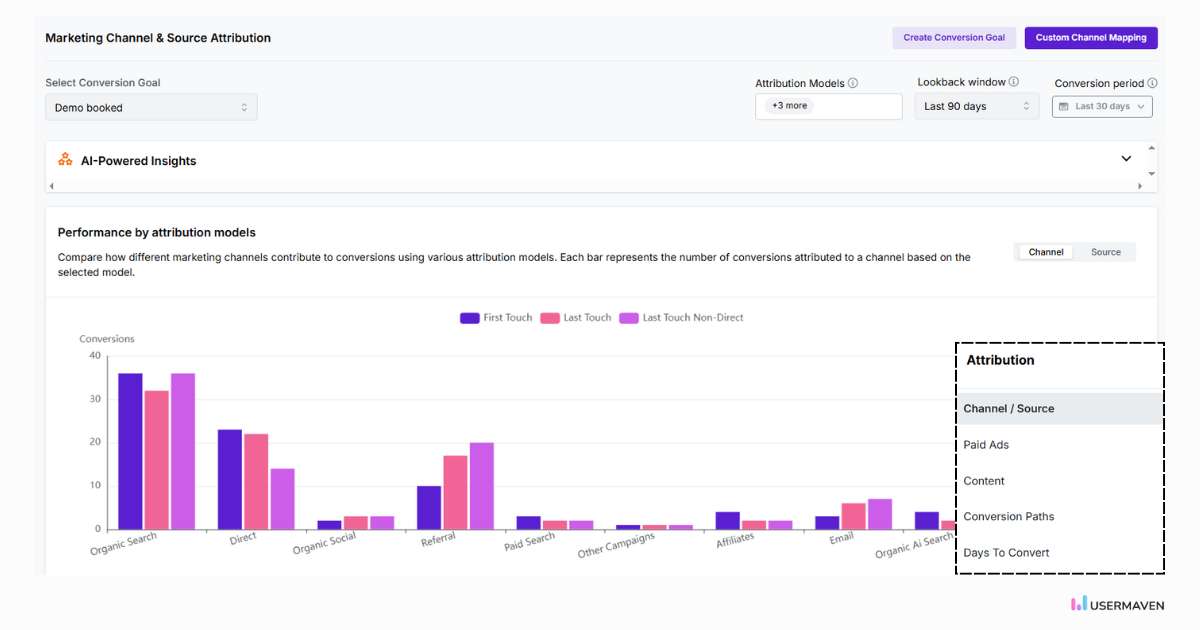
Whether you’re using first-touch, last-touch, or multi-touch attribution, these models give you a comprehensive view of your marketing efforts and how they’re influencing user behavior.
By understanding which campaigns, ads, or channels are most effective, you avoid the trap of celebrating vanity metrics, such as a surge in traffic or social media engagement, without knowing if they are actually leading to business outcomes.
Attribution models help you see the full picture, allowing you to identify where your efforts are paying off and where adjustments are needed. This ensures you’re focusing on the metrics that truly matter, guiding you on where to double down and where to pivot so that you can allocate your resources more effectively.
User journeys
Understanding your users’ journeys is key to knowing what works and what doesn’t. Usermaven’s user journey tool maps out how customers navigate your product. This provides a complete view of how your customers interact with your product or service, from the very first touchpoint all the way to conversion.

This feature helps you visualize the steps users take, where they drop off, and where they engage most. Instead of relying on surface-level metrics like total visits or clicks, you can delve deeper into how users navigate your site or app and identify areas where you might be losing them.
User journey mapping is about understanding the customer experience; something vanity metrics can’t show you.
Behavioral analytics
When it comes to understanding your users, behavioral analytics helps you cut through the noise of vanity metrics. Instead of getting distracted by metrics like total page views or social media likes, this approach reveals what users are actually doing on your site or app.
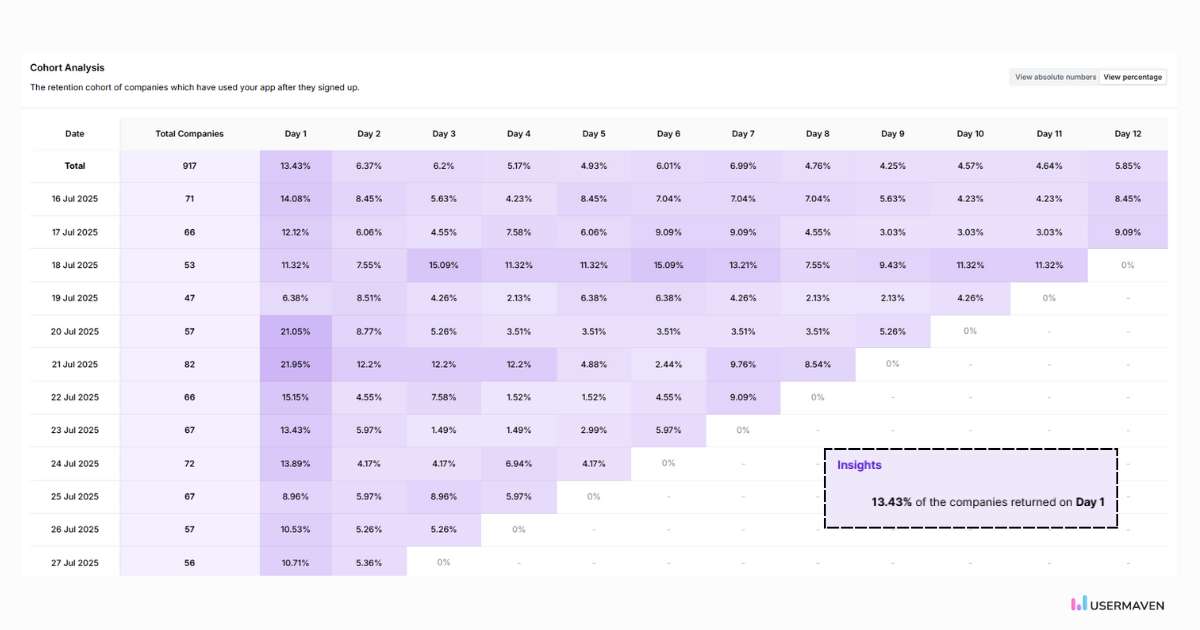
With behavioral analytics, you can track how users are engaging with your site or app. Are they interacting with key elements, such as product pages or call-to-action buttons? Or are they bouncing without taking any meaningful steps? This insight helps you see where users are truly engaged and where they might be dropping off.
This is especially important because, as research shows, 66% of customers say they will stop supporting a brand if their experience isn’t personalized. By understanding how users behave, you can tailor the experience to meet their needs and expectations, keeping them engaged and loyal.
This approach helps you move away from vanity metrics, which often don’t provide meaningful insights into real user engagement or business growth. Behavioral analytics enables you to understand engagement on a deeper level, so you can make informed decisions and prioritize what truly matters for your business. Rather than chasing numbers that don’t reflect actual growth, you’ll be equipped with data that helps you make improvements where it counts.
Dashboards
The way you visualize and report on your data makes all the difference. Customizable dashboards are designed to highlight the metrics that matter most to your business, such as conversion rates, engagement levels, and customer satisfaction.
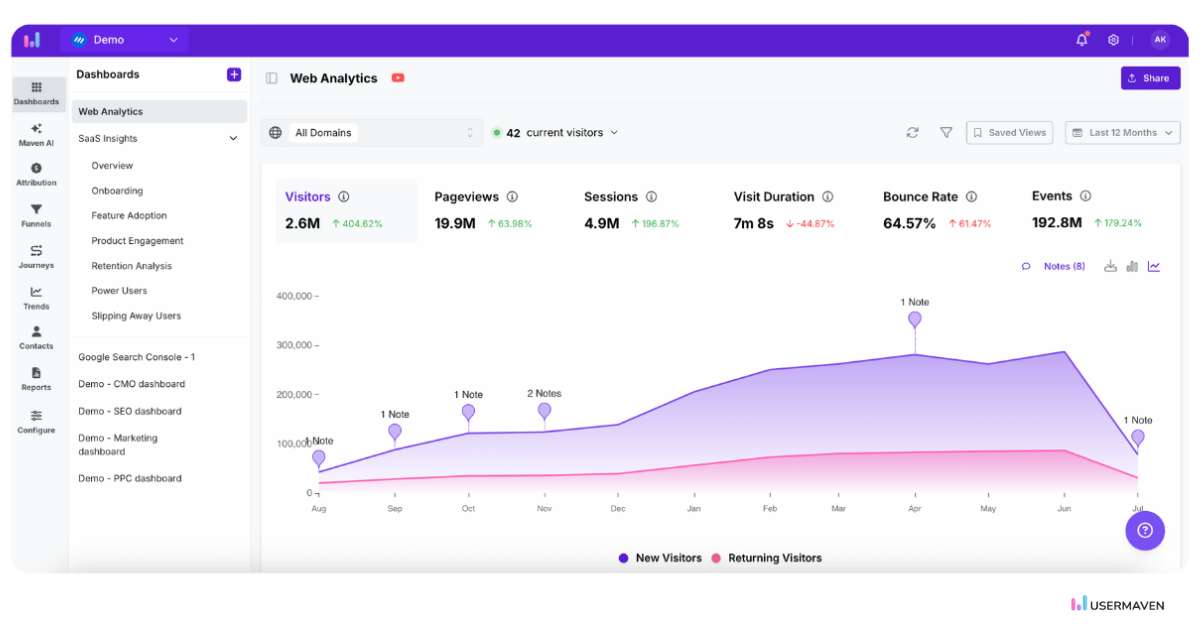
With clear, easy-to-understand dashboards, you can leave behind vanity metrics that may appear impressive but don’t actually help you make informed decisions. These dashboards focus on key business outcomes, not superficial data points.
Whether you’re tracking sales performance, user engagement, or ROI, the metrics on your dashboard will always align with your business goals, helping you stay on track and make smarter decisions.
Advanced segmentation
Segmentation is the key to breaking down your data into meaningful, actionable insights. Usermaven’s segments feature allows you to slice your data in ways that make sense for your business: by behavior, demographics, engagement levels, or product usage.
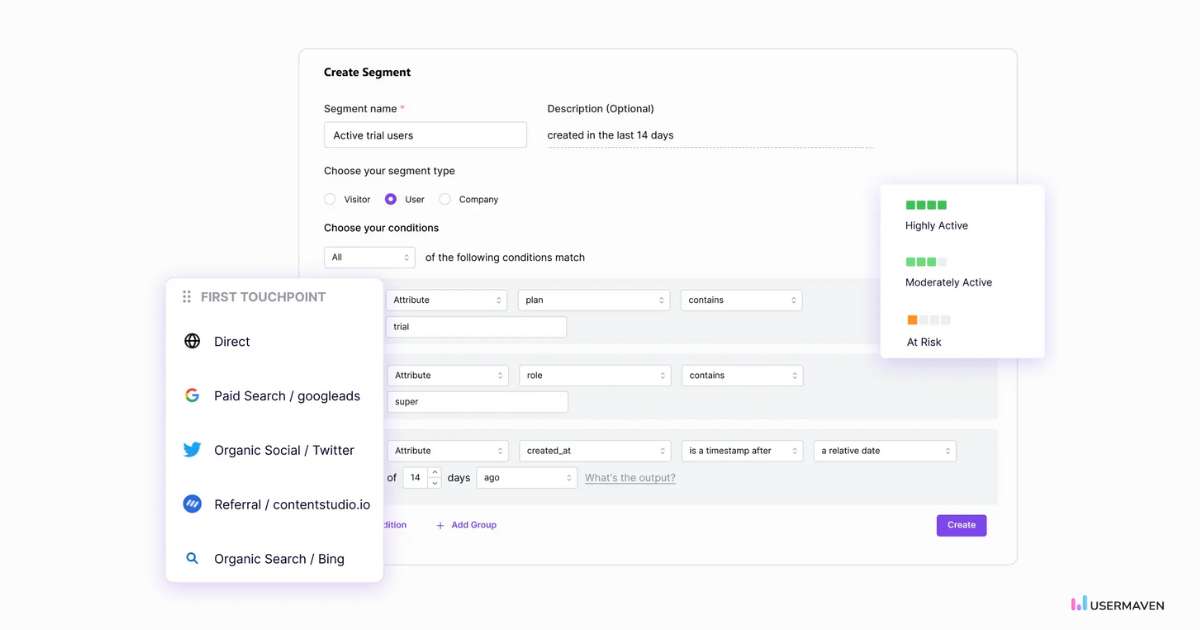
This level of granularity helps you avoid generic metrics, such as total traffic or broad engagement numbers. Instead, you can dig deeper into which specific segments are driving growth, identify the bottlenecks, and determine the necessary actions to improve. By focusing on meaningful segments, you can gain a deeper understanding of your customers, refine your targeting, and boost conversions.
Usermaven helps you focus on metrics that truly matter, moving you beyond the surface-level numbers that feel good but don’t drive real growth. With features like attribution and behavioral analytics, you can see exactly how users interact with your product and understand what’s truly making an impact.
Instead of getting distracted by vanity metrics, you can focus on the data that aligns with your goals. You’ll know which actions are actually pushing your business forward and which ones are just noise.
So, next time you look at your metrics, ask yourself: Is this just a shiny number, or is this what will help me grow? Usermaven will help you see the difference.
Wrapping it up
Vanity metrics may look impressive at first glance, but as we’ve seen, they often don’t tell you much about what’s really driving your business. On the other hand, actionable metrics provide the insights you need to make informed decisions and achieve genuine growth. These metrics provide a clearer picture of your business performance, helping you align your efforts with your goals.
So, what’s next? It’s time to take a closer look at your current metrics. Are you focusing on numbers that matter, or are you caught up in shiny stats that don’t lead to meaningful outcomes? Moving forward, consider adopting a more focused and actionable approach.
The good news is, it’s not too late to make the switch. By adopting a more focused and actionable approach, you can prioritize the data that truly matters. Platforms like Usermaven can help streamline this process, providing you with the tools to track meaningful insights, make data-driven decisions, and steer your business in the right direction.
It’s not about getting lost in stats; it’s about harnessing the right ones to create sustainable growth. With the right metrics, you’ll be set up for the long haul.
See what's working. Fix what's not. Grow faster.
*No credit card required
FAQs about vanity metrics
1. What are vanity metrics?
Vanity metrics are data points that look impressive on the surface but don’t provide meaningful insights into business performance or guide decision-making.
2. How can vanity metrics be harmful to startups?
Startups may focus on vanity metrics, such as total signups, while overlooking deeper engagement metrics, which can lead to misguided strategies and potential resource misallocation.
3. Can vanity metrics ever be useful?
Yes, when used in conjunction with actionable metrics to provide context or track early-stage engagement, but they shouldn’t be relied upon exclusively.
4. How can Usermaven help in avoiding vanity metrics?
Usermaven offers tools to track meaningful metrics, providing insights that help businesses focus on what truly drives growth and performance.
Try for free
Grow your business faster with:
- AI-powered analytics & attribution
- No-code event tracking
- Privacy-friendly setup


